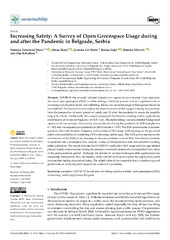Приказ основних података о документу
Increasing Safety: A Survey of Open Greenspace Usage during and after the Pandemic in Belgrade, Serbia
| dc.creator | Golubović Matić, Darinka | |
| dc.creator | Marić, Jelena | |
| dc.creator | Matić, Jovanka Lili | |
| dc.creator | Gajić, Ranka | |
| dc.creator | Mitrović, Biserka | |
| dc.creator | Krčadinac, Olja | |
| dc.date.accessioned | 2024-04-10T13:09:14Z | |
| dc.date.available | 2024-04-10T13:09:14Z | |
| dc.date.issued | 2024 | |
| dc.identifier.issn | 2071-1050 | |
| dc.identifier.uri | https://raf.arh.bg.ac.rs/handle/123456789/2130 | |
| dc.description.abstract | COVID-19 has severely affected almost every aspect of our everyday lives, especially the use of open greenspace (OGS) in urban settings, which has proven to have a significant role in increasing overall public health and well-being. Hence, the restricted usage of these spaces should be reconsidered. This research aims to analyze the sensitive nature of OGS usage (1) during the pandemic from the perspective of users’ perceived safety and (2) after the pandemic to assess the possible long-term effects. Additionally, this research proposed that location-tracking mobile applications could lead to an increased frequency of OGS visits. The methodology contains detailed background research and two surveys. One survey was conducted during the pandemic in 2020 (sample size n = 412) and was repeated post-pandemic in 2024 (sample n = 451). The 2020 questionnaire A includes questions about the duration, frequency, and activities of OGS usage while focusing on the perceived safety and possibilities of monitoring OGS visits using mobile apps. The 2024 survey represents the continuation of the 2020 survey, focusing on the post-pandemic state of OGS. The statistical analysis is separated into a descriptive data analysis, various χ2 independence tests and a machine learning safety prediction. The results indicate how COVID-19 could affect OGS usage and how app-related physical safety enhancements during the pandemic cannot be statistically distinguished from those in the post-pandemic period. Although the interest in location-tracking mobile applications has statistically decreased in 2024, the majority of the total 863 participants stated that applications could increase their feeling of perceived safety. The added value of this research is that it considers age and gender roles in analyzing OGS usage in the context of a pandemic. | sr |
| dc.language.iso | en | sr |
| dc.publisher | MDPI | sr |
| dc.rights | openAccess | sr |
| dc.rights.uri | https://creativecommons.org/licenses/by/4.0/ | |
| dc.source | Sustainability | sr |
| dc.subject | pandemic | sr |
| dc.subject | COVID-19 | sr |
| dc.subject | health and well-being | sr |
| dc.subject | perceived safety | sr |
| dc.subject | open greenspace (OGS) | sr |
| dc.subject | monitoring | sr |
| dc.subject | mobile application | sr |
| dc.subject | Belgrade | sr |
| dc.title | Increasing Safety: A Survey of Open Greenspace Usage during and after the Pandemic in Belgrade, Serbia | sr |
| dc.type | article | sr |
| dc.rights.license | BY | sr |
| dcterms.abstract | Гајић, Ранка; Митровић, Бисерка; Крчадинац, Оља; Голубовић Матић, Даринка; Марић, Јелена; Матић, Јованка Лили; | |
| dc.citation.volume | 16 | |
| dc.citation.issue | 9 | |
| dc.citation.spage | 3141 | |
| dc.identifier.doi | 10.3390/su16083141 | |
| dc.identifier.fulltext | http://raf.arh.bg.ac.rs/bitstream/id/7520/sustainability-16-03141.pdf | |
| dc.type.version | publishedVersion | sr |

